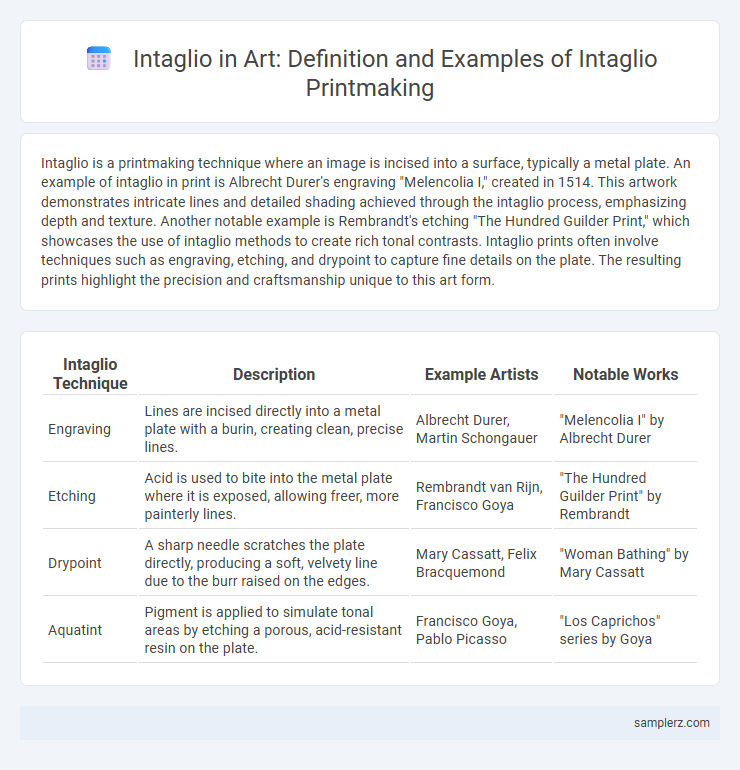Intaglio is a printmaking technique where an image is incised into a surface, typically a metal plate. An example of intaglio in print is Albrecht Durer's engraving "Melencolia I," created in 1514. This artwork demonstrates intricate lines and detailed shading achieved through the intaglio process, emphasizing depth and texture. Another notable example is Rembrandt's etching "The Hundred Guilder Print," which showcases the use of intaglio methods to create rich tonal contrasts. Intaglio prints often involve techniques such as engraving, etching, and drypoint to capture fine details on the plate. The resulting prints highlight the precision and craftsmanship unique to this art form.
Table of Comparison
| Intaglio Technique | Description | Example Artists | Notable Works |
|---|---|---|---|
| Engraving | Lines are incised directly into a metal plate with a burin, creating clean, precise lines. | Albrecht Durer, Martin Schongauer | "Melencolia I" by Albrecht Durer |
| Etching | Acid is used to bite into the metal plate where it is exposed, allowing freer, more painterly lines. | Rembrandt van Rijn, Francisco Goya | "The Hundred Guilder Print" by Rembrandt |
| Drypoint | A sharp needle scratches the plate directly, producing a soft, velvety line due to the burr raised on the edges. | Mary Cassatt, Felix Bracquemond | "Woman Bathing" by Mary Cassatt |
| Aquatint | Pigment is applied to simulate tonal areas by etching a porous, acid-resistant resin on the plate. | Francisco Goya, Pablo Picasso | "Los Caprichos" series by Goya |
Introduction to Intaglio Printmaking
Intaglio printmaking involves engraving or etching designs into a metal plate, commonly copper or zinc, to create detailed and textured prints. Fine lines and rich tonal variations are achieved by inking the grooves and wiping the surface clean before pressing paper onto the plate. Famous historical examples include Rembrandt's etchings and Goya's aquatints, showcasing the technique's capacity for intricate detail and expressive depth.
Historical Evolution of Intaglio Techniques
The historical evolution of intaglio techniques is marked by the advancement from simple line engravings in the 15th century to complex mezzotint and aquatint processes in the 17th and 18th centuries. Early pioneers like Albrecht Durer and Rembrandt van Rijn expanded the expressive potential of intaglio by refining etching and engraving methods. These developments laid the foundation for modern printmaking, allowing artists to achieve intricate details and tonal variation through controlled ink retention in recessed surfaces.
Etching: A Classic Intaglio Example
Etching exemplifies classic intaglio printmaking, where acid bites into a metal plate to create intricate designs. Artists coat a copper or zinc plate with a protective ground before drawing, allowing precise line work and tonal variations. This technique yields highly detailed prints with rich textures, favored by masters like Rembrandt and Goya.
Engraving: Precision in Print
Engraving exemplifies intaglio printmaking by incising fine lines into a metal plate using a burin, creating precise, detailed images. This technique allows for sharp contrasts and intricate textures, evident in works by masters like Albrecht Durer. The engraved lines hold ink below the plate's surface, transferring rich, defined prints onto paper during the press process.
Aquatint: Creating Tones in Intaglio
Aquatint is a printmaking technique within intaglio that allows artists to create tonal variations by etching a metal plate with acid through a powdered resin ground. This method produces textured, grainy areas that mimic watercolor washes, enabling nuanced shading and depth in prints. Artists such as Francisco Goya extensively used aquatint to achieve dramatic contrasts and subtle gradations in their etchings.
Drypoint: Expressive Lines in Print
Drypoint intaglio printmaking employs a sharp needle to scratch fine, expressive lines directly onto a metal plate, creating rich, velvety textures when ink is applied. This technique emphasizes subtle line variation and depth, capturing intricate details and spontaneous gestures. Renowned artists like Rembrandt and Mary Cassatt utilized drypoint to enhance emotional intensity and tactile quality in their prints.
Mezzotint: Achieving Rich Gradations
Mezzotint, a prominent intaglio technique, enables artists to achieve rich gradations by roughening the entire metal plate surface and then smoothing areas to create gradients from dark to light. This method produces prints with velvety blacks and subtle tonal transitions, offering depth and warmth unattainable by other intaglio processes. Masters like Ludwig von Siegen and John Smith popularized mezzotint in the 17th century, using it to reproduce paintings with remarkable tonal richness.
Famous Artists Who Mastered Intaglio
Albrecht Durer revolutionized intaglio with his detailed engravings that captured intricate textures and shading, influencing Renaissance printmaking. Rembrandt van Rijn elevated etching techniques, producing emotionally charged scenes with profound depth and contrast. Francisco Goya utilized aquatint intaglio to create powerful social and political critiques, evident in his series "Los Caprichos.
Iconic Intaglio Artworks Through History
Rembrandt van Rijn's "The Three Crosses" exemplifies masterful intaglio printmaking, showcasing intricate line work and dynamic contrasts. Francisco Goya's "Los Caprichos" series highlights intaglio techniques to convey social critiques with powerful imagery and shading. These iconic artworks illustrate intaglio's historical significance in producing detailed, expressive prints that remain influential.
Intaglio in Contemporary Printmaking
Contemporary intaglio printmaking techniques showcase intricate line work and rich textural contrasts, achieved through methods like etching, drypoint, and aquatint. Artists utilize zinc or copper plates to create detailed designs that capture fine gradations of tone and depth. This process remains a vital medium in modern print studios, enabling expressive, high-resolution imagery not easily replicated by other printing techniques.

example of intaglio in print Infographic
 samplerz.com
samplerz.com